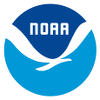
Lake Erie Data
NOAA Great Lakes Environmental Research Laboratory (GLERL) in collaboration with researchers from the U.S. and Canada have initiated one of the largest, most comprehensive Lake Erie research field programs ever conducted. The project, the International Field Years on Lake Erie (IFYLE), began in May 2005, with a focus on hypoxia and harmful algal blooms.
The Lake Erie ecosystem faces wide and varied threats to its health and integrity, including harmful algal blooms (HABs) in the west basin, recurring low oxygen episodes (“dead zones”) in the central basin, and invasive species. Each of these threats has the potential to disrupt normal food web and ecosystem processes, and in turn, jeopardize the ability of Lake Erie to provide valued ecosystem services (e.g., recreational and commercial fish production, safe drinking water, and clean, bacteria-free beaches).
The three primary objectives of the IFYLE program are to:
- Quantify the spatial extent of hypoxia across the lake, and gather information that can help forecast its timing, duration, and extent;
- Assess the ecological consequences of hypoxia to the Lake Erie food web, including phytoplankton, bacteria, microzooplankton, mesozooplankton, and fish;
- Identify factors that control the timing, extent, and duration of HAB (including toxin) formation in Lake Erie, as well as enhance our ability to use remote sensing as a tool to rapidly map HAB distributions in the lake.
The IFYLE program involves approximately 40 scientists from NOAA, 17 different universities, and private institutions spread across 7 states and 4 countries. This program is integrative, given involvement by numerous US and Canadian universities and federal, state, and provincial agencies, and serves as an example of how NOAA and other federal agencies are fulfilling the Presidential Executive Order (#13340) to execute the Great Lakes Regional Collaboration among agencies.
For more information contact:
- Doran Mason: Program Manager


